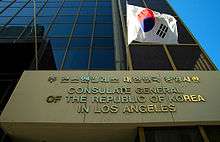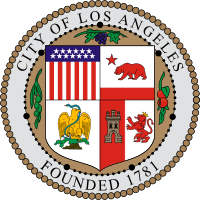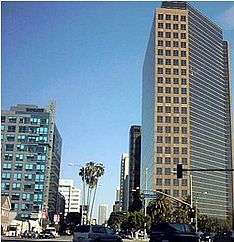Koreatown, Los Angeles
| Koreatown | |
|---|---|
| Neighborhood of Los Angeles | |
 City of Los Angeles Koreatown marker | |
| Nickname(s): "K-Town" | |
 Koreatown Location in Los Angeles | |
| Coordinates: 34°03′42″N 118°18′02″W / 34.0618°N 118.3006°WCoordinates: 34°03′42″N 118°18′02″W / 34.0618°N 118.3006°W | |
| Country |
|
| State |
|
| County |
|
| City |
|
| Government | |
| • City Council | Herb Wesson, David Ryu |
| • State Assembly | Miguel Santiago (D) |
| • State Senate | Kevin De León (D) |
| • U.S. House | vacant |
| Area[1] | |
| • Total | 7 km2 (2.7 sq mi) |
| Population (2008)[1] | |
| • Total | 124,281 |
| • Density | 16,451/km2 (42,609/sq mi) |
| Population changes significantly depending on areas included and recent growth. | |
| ZIP Code | 90010, 90005, 90006 |
| Area code(s) | 323 213! |
Koreatown is a neighborhood in Central Los Angeles, California, centered near Eighth Street and Irolo Street.[2] Koreans began immigrating in larger numbers in the 1960s and found housing in the Mid-Wilshire area. Many opened businesses as they found rent and tolerance towards the growing Korean population. Many of the historic Art deco buildings with terra cotta facades have been preserved because the buildings remained economically viable for the new businesses.[3] Today, Koreatown is quickly becoming one of LA's most popular neighborhoods; David Chang, world-renowned chef and founder of the Momofuku Restaurant Group, has called it the "most exciting place to eat in America."[4]
Koreatown is the most densely populated district by population in Los Angeles County, with 120,000 residents in 2.7 square miles. Despite the name evoking a traditional ethnic enclave, the community is complex and has an impact on areas outside the traditional boundaries. While the neighborhood culture has historically been oriented to the Korean immigrant population, Korean business owners are creating stronger ties to the Latino community in Koreatown.[5] The community is highly diverse ethnically, with half the residents being Latino and a third being Asian. Two-thirds of the residents were born outside of the United States, a high figure compared to the rest of the city.[1]
History
1900s-1980s
In 1882, the United States and Korea established the United States-Korea Treaty of 1882, which ended Korea’s self-imposed isolation.[6] The establishment of diplomatic relations between the United States and Korea paved the way for Korean immigration to Hawaii in the late 1880s.[7] In the early 1900s, Korean immigrants began making their way to Los Angeles, where they created communities based around ethnic churches.[7] As the number of Koreans increased to the hundreds, their residential and commercial activities spread to the southwestern corner of the Los Angeles business district, putting them within walking distance of Little Tokyo and Chinatown.[7]
By the 1930s, approximately 650 Koreans resided in Los Angeles.[7] They established churches, restaurants, and community organizations, as well as businesses that primarily focused on vegetable and fruit distribution.[7] However, racial covenant laws and economic constraints limited Korean residents to an area bounded by Adams Boulevard to the north, Slauson Boulevard to the south, Western Avenue to the west, and Vermont Avenue to the east.[8] The 1930s also saw the height of the area's association with Hollywood. The Ambassador Hotel hosted the Academy Awards ceremony in 1930, 1931, 1932, and 1934.[9] As the entertainment industry grew in the surrounding Koreatown area, Koreans remained segregated into low-income districts because of discriminatory housing policies.[10] After the 1948 Shelley v. Kraemer Supreme Court case prohibited racially restrictive housing policies, Koreans began to move north of Olympic Boulevard to establish new homes and businesses.[10]
In the late 1960s, the surrounding neighborhood began to enter a steep economic decline. The once-glamorous mid-Wilshire area became filled with vacant commercial and office space that attracted wealthier South Korean immigrants. They found inexpensive housing and many opened businesses in Koreatown. Many of the area's Art Deco buildings with terracotta facades were preserved because they remained economically viable with the new commercial activity that occupied them.[3] The Immigration and Nationality Act of 1965 removed restrictions on Asian migration and helped further the growth of the immigrant community in Koreatown.
By the late 1970s, most businesses in the Olympic Boulevard and 8th Street areas were owned by Koreans.[10] This economic boom led to the creation of Korean media outlets and community organizations, which played a key role in developing a sense of communal identity in the neighborhood.[10] The ethnic enclave was able to establish itself as the primary hub of the Korean community in Southern California, and the residents successfully lobbied for the installation of the first Koreatown sign in 1982.[10]
1992 Los Angeles civil unrest
The 1992 Los Angeles civil unrest had a significant impact on the community (see Figure 1), solidifying the importance of community-based nonprofit organizations, such as the Koreatown Youth and Community Center (KYCC) and Koreatown Immigrant Workers Alliance (KIWA) (see Community Organizations section) (Chung, 2005).[11] These organizations advocated for reparations and protections for Korean Americans, who received little support from government authorities as a result of their low social status and language barrier.[12] The 1992 unrest stimulated a new wave of political activism among Korean-Americans, but also split them into two camps. The liberals sought to unite with other minorities in Los Angeles to fight against racial oppression and scapegoating. The conservatives emphasized law and order and generally favored the economic and social policies of the Republican Party. The conservatives also tended to emphasize the political differences between Koreans and other minorities, specifically Blacks and Hispanics.[13][14] Despite this divide within the Korean American community, the 1992 riots also inspired further efforts to build coalitions rooted in intersectionality. The 1992 Koreatown Peace Rally was a record-setting demonstration with over 30,000 attendees representing intergenerational and interethnic solidarity.[15]
2000s-present
In late 2008, the City of Los Angeles designated Koreatown a special graphics district (along with Hollywood and the downtown neighborhood of South Park/LA Live). The designation allows for digital signage and electronic billboards, not permitted by city code, to be installed on building facades. The designation allowed Times Square and Shibuya District-inspired buildings lined with LCD jumbotrons. The 300-square block graphics district is bordered by 6th Street and Olympic Boulevard from the north and south, and St. Andrews Place and Shatto from the west to east.[16]
Koreatown has become a commercially driven area, yet continues to face pressing social and economic problems, including poverty and gentrification.[7] The controversial construction of the Robert F. Kennedy Community Schools at the former site of the Ambassador Hotel highlighted the challenge of balancing resource expansion with business development and historic preservation (see Figure 2).[10] The schools were constructed with the intention of increasing educational opportunities for low-income Latina/Latino and Korean students,[17] but the $578 million construction cost made the complex the most expensive public school in United States history.[17] Other developments, such as the opening of new metro stations, shopping centers, and strip malls, have made Koreatown a popular tourist destination while also increasing economic inequality for locals.[10]
Since Koreatown has a Latino majority,[18] it's not unusual to find Latino employees in restaurants and grocery stores speaking Korean with customers or Korean store owners engaging Latino customers in Spanish.[19] An example of a cultural interchange between Koreans and Latinos in Koreatown is the popularity of Korean-inspired taco trucks in Los Angeles that feature classic Mexican food infused with Korean ingredients.[20]
Geography

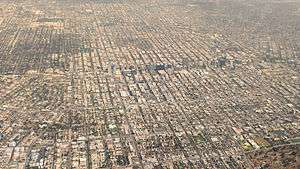
The neighborhood lies 3 miles (5 km) west of downtown, 4 miles (6 km) southeast of Hollywood, 12 miles (19 km) from Santa Monica Beach and 16 miles (26 km) from Los Angeles International Airport. It is generally flat, with an average elevation of 200 feet (61 m).[2] The neighborhood is flanked by East Hollywood to the north, Westlake to the east, Pico-Union, Harvard Heights and Arlington Heights to the south, Mid-Wilshire and Windsor Square to the west and Larchmont to the northwest.[21][22][23]
Boundary changes over time
The boundaries of Koreatown have shifted over time due to economic factors, housing discrimination, and demographic changes. In the early 1900s, Koreans clustered around the downtown Los Angeles Bunker Hill area.[10] This housing segregation was due to racial covenant laws that restricted them to mixed-race, low-income districts.[10] By the 1930s, Koreans began to move to Jefferson Boulevard between Western and Vermont Avenue.[10]
The next major shift in geographic boundaries began in the 1960s. As the African American population increased in southern Los Angeles, middle-class White Americans began to move out of the mid-Wilshire district.[10] The area north of Olympic Boulevard transitioned from a predominantly white suburb to a home for Asian residents.[7] The area has become the mainstay of the Korean American community, although varying sources have established different boundaries for Koreatown (see Figure 3).
City of Los Angeles boundaries
The city of Los Angeles has set the official boundaries for Koreatown as Vermont Avenue on the east, Western Avenue on the west, Third Street on the north, and Olympic Boulevard on the south. A business corridor running about 3/4 of a mile along Western Avenue to Rosewood Avenue is also included as part of Koreatown.[24][25][26]
The Koreatown Regional Commercial Center runs along Olympic Boulevard and is "generally bounded by Eighth Street on the north, Twelfth Street on the south, Western Avenue on the west, and continues east towards Vermont Avenue", according to the Los Angeles Wilshire Community Plan.[27]
Google Maps
Google Maps draws the following boundaries for Koreatown: Vermont Avenue on the East, Western Avenue on the West, Third Street on the North and Olympic Boulevard on the South.
Mapping L.A. boundaries
The Mapping L.A. project of the Los Angeles Times has the following boundaries for Koreatown:
Koreatown is bounded by Beverly Boulevard on the north, Virgil Avenue, Wilshire Place and Westmoreland Avenue on the east, Olympic Boulevard on the south and Crenshaw Boulevard and Wilton Place on the west. The neighborhood is flanked by East Hollywood to the north, Westlake to the east, Pico-Union, Harvard Heights and Arlington Heights to the south, Mid-Wilshire and Windsor Square to the west and Larchmont to the northwest.[28]

Demographics
The 2000 U.S. census counted 115,070 residents in the 2.7-square-mile neighborhood—an average of 42,611 people per square mile, the highest density of any community in Los Angeles County. In 2008, the city estimated that the population had increased to 124,281. The median age for residents was 30, an average age for both the city and Los Angeles County.[28] These were the ten neighborhoods or cities in Los Angeles County with the highest population densities, according to the 2000 census, with the population per square mile:[29]
- Koreatown, Los Angeles, 42,611
- Westlake, Los Angeles, 38,214
- East Hollywood, Los Angeles, 31,095
- Pico-Union, Los Angeles, 25,352
- Maywood, California, 23,638
- Harvard Heights, Los Angeles, 23,473
- Hollywood, Los Angeles, 22,193
- Walnut Park, California, 22,028
- Palms, Los Angeles, 21,870
- Adams-Normandie, Los Angeles, 21,848
Koreatown is considered "highly diverse" ethnically. The breakdown is Latinos, 53.5%; Asians, 32.2%; whites, 7.4%; blacks, 4.8%, and others, 2%. Korea (28.6%) and Mexico (23.9%) were the most common places of birth for the 68% of the residents who were born abroad, a figure that is considered high compared to the city as a whole.[28]
The median annual household income in 2008 dollars was $30,558, a low figure for Los Angeles, and the percentage of households that earned less than $20,000 was high. The average household size of 2.7 people was about the same as the rest of the city. Renters occupied 93% of the housing units, and house- or apartment owners the rest.[28]
The percentages of never-married men and women, 44.6% and 36.2%, respectively, were among the county's highest. There were 2,833 military veterans in 2000, or 3.3%, a low figure for Los Angeles.[28]
Economy
Olympic Boulevard has blocks dominated by Korean-language signs and new blue-tile-roofed shopping centers. This initial Korean business area has spread to an area bounded by Olympic Boulevard, Vermont Avenue, 8th Street and Western Avenue. The Korean business area also sprawls to the north and south along Western and Vermont for three miles, and to the east and west along Olympic for two miles.[30] South Korean investment has been a large contributor to the neighborhood economy since the 1960s. Since the early 2000s, that investment has increased greatly, ballooning to an estimated $1 billion in new construction investment.[31] The area also has a vibrant nightlife with many lively restaurants and clubs, especially Korean barbeque restaurants and karaoke bars.[3][32]
Asiana Airlines operates a sales office in Koreatown.[33] Korean Air's United States Passenger Operations headquarters are located in close proximity to Koreatown in the Westlake community.[34] Grupo TACA operates a Los Angeles-area TACA Center in Suite 100P at 3600 Wilshire Boulevard.[35]
The Consulate-General of South Korea in Los Angeles is at 3243 Wilshire Boulevard.[36] The Consulate General of the People's Republic of China in Los Angeles is at 443 Shatto Place, while the passport and visa office is on the third floor of 500 Shatto Place.[37] The Consulate General of El Salvador is at 3450 Wilshire Blvd. Suite 250 and the Consulate General of Guatemala is at 3540 Wilshire Blvd. Suite 100 . The Consulate General of Honduras and Nicaragua are at 3550 Wilshire Blvd. The Consulate General of Bolivia is at 3701 Wilshire Blvd #1056. The Consulate General of Indonesia is at 3457 Wilshire Blvd. .
Government
The Wilshire Center - Koreatown Neighborhood Council is designated by the City of Los Angeles to represent the area's citizens' concerns to the city, as a supplement to the City Council representation. The area represented by the council includes Koreatown & Wilshire Center, as well as parts of MacArthur Park, Hancock Park, and Mid-Wilshire.
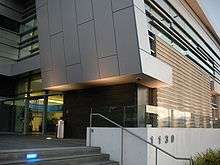
Representatives
Koreatown lies within Los Angeles City Council District 10 and is represented on the city council by Herb J. Wesson, Jr. The area is represented by Mark Ridley-Thomas, Supervisor of District 2 for Los Angeles County. Mike Davis is the State Assemblyman for the Koreatown area. Karen Bass of California's 37th congressional district represents the area in the United States House of Representatives.[38]
Fire service
Four Fire Stations of the Los Angeles Fire Department serve Koreatown:
Station 29 serving Southwest Koreatown at Wilshire Blvd. and Wilton Avenue.
Station 13 serving Southeast Koreatown at Pico Blvd. and Westmoreland Avenue.
Station 52 serving Northwest Koreatown at Melrose Avenue and Western Avenue.
Station 6 serving Northeast Koreatown at Temple Street and Virgil Avenue.
Police service
The Los Angeles Police Department provides police service to the City of Los Angeles, broken up into 21 local divisions. Koreatown is served by Olympic Division. The new station completed construction and opened for service on January 4, 2009.[39]
Education
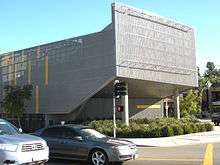
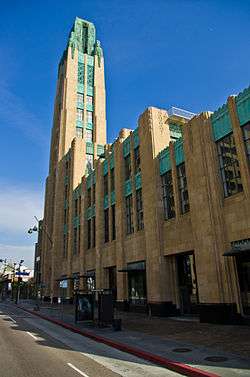
21.4% of Koreatown residents aged 25 and older have a four-year degree, an average rate for both the city and the county. The percentage of residents with less than a high school diploma was high for the county.[28]
Schools within the Koreatown borders are:[40]
- Central City Value, LAUSD charter high school, 221 North Westmoreland Avenue
- Ambassador School of Global Leadership, LAUSD K-12, 701 South Catalina Street
- New Open World Academy, LAUSD K-12, 3201 West Eighth Street
- UCLA Community School, LAUSD K-12, 701 South Catalina Street[41]
- Virgil Middle School, LAUSD, 152 North Vermont Avenue
- Young Oak Kim Academy, LAUSD, 615 S. Shatto Place
- Cahuenga Elementary School, LAUSD, 220 South Hobart Boulevard
- Saint Brendan School, private elementary, 238 South Manhattan Place
- New Horizon School/Los Angeles, private elementary, 434 South Vermont Avenue
- Saint James' Episcopal Day School, private elementary, 625 South Saint Andrews Place
- Camino Nuevo Charter Academy, LAUSD charter, 697 South Burlington Avenue
- Saint Gregory Nazianzen, private elementary, 911 South Norton Avenue
- Wilton Place Elementary School, LAUSD, 745 South Wilton Place
- Hobart Boulevard Elementary School, LAUSD, 980 South Hobart Boulevard
- Mariposa-Nabi Primary Center, LAUSD, 987 South Mariposa Avenue
- Pilgrim School, private preK-12, 540 South Commonwealth Avenue
Other education
The Korean Education Center, affiliated with the government of South Korea, is in Suite 200 at 680 Wilshire Place.[36]
Southwestern Law School offers degree and non-degree programs in the Westmoreland Building and the former Bullock's Wilshire building at 3050 Wilshire Boulevard.[42]
Public libraries
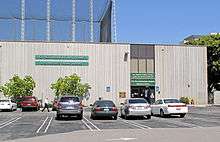
- Pio Pico Koreatown Branch Library (피오 피코 코리아타운 도서관) of the Los Angeles Public Library serves the area.
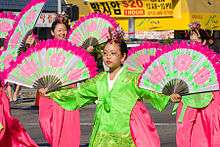
Festivals
Annual festivals include the Korean Festival & Parade on Olympic Boulevard, with a march to the Seoul Peace Park. The Wilshire Center Business Improvement District (WCBID) holds the annual Earth Day / Car Free Day Festival every April 22 on Wilshire.[43] KTOWN Night Market holds an annual festival at Robert F. Kennedy Community Schools.[44]
Community organizations
- Koreatown Immigrant Workers Alliance (KIWA) has organized the community on behalf of significant social change
Transportation

The Los Angeles County Metropolitan Transportation Authority operates two subway lines in or near Koreatown — the Red Line, beneath Vermont Avenue, and the Purple Line, beneath Wilshire Boulevard. The neighborhood is served primarily by the Purple Line Wilshire/Normandie station, but there are two other stops, Wilshire/Vermont and Wilshire/Western.[21]
In addition to the two subway lines, Metro operates numerous Express, Rapid and Local bus lines in the district. Rapid lines include the 710 Crenshaw, 720 Wilshire, 728 Olympic, 754 Vermont, and 757 Western. Local lines include the 207 Western, 20 Wilshire/Westwood, 204 Vermont and 206 Normandie. Many MTA bus lines in Koreatown offer 24-hour service.
The LADOT operates three district-to-district DASH routes, one Commuter Express line and Cityride. Koreatown is served by DASH Hollywood/Wilshire line and Dash Koreatown. The DASH lines are meant for local neighborhood transportation; their routes are shorter than MTA lines. DASH service ends at 7pm weekdays and only Dash Koreatown operates on weekends, ending service at 6pm. DASH fares are 50 cents. Commuter Express line 534 Century City provides weekday service while Cityride offers door to door dial-a-ride service for the elderly and disabled.
Foothill Transit services one express line in Koreatown, line 481. It operates only during weekday rush hours and runs from Wilshire and St. Andrews to the El Monte Bus Station.
Publicly accessible places

When it opened in 1929, the gracious structure on 6th Street was an architectural wonder, featuring the novel concept of one-stop shopping for fresh produce, meat and dry goods. It was an urbane attraction in the fashionable Wilshire District at a time when movie stars played at the nearby Ambassador Hotel.[46]
- LA Metro subway station, Western Avenue and Wilshire Boulevard.[21]
- The Line Hotel at Normandie Avenue.[21]
- The Wiltern Theater at Wilshire Boulevard and Western Avenue.[21]
- Koreatown Plaza shopping center, Western Avenue between James Wood Boulevard and San Marino Street.[21]
- Wilshire Gramercy Plaza shopping center, northwest corner of Wilshire and Wilton.[21][47]
- Seoul International Park, formerly Ardmore Recreation Center, 3250 San Marino Street at Irolo Street. The indoor gymnasium is also used as an auditorium with 400 seats. The center is an LAPD drop-in center and features a children's play area.[21][48]
- Shatto Recreation Center, 3250 San Marino Street at Westmoreland Avenue, where the indoor gymnasium can be used as a 383-seat auditorium. There is a baseball diamond (lighted), basketball courts (lighted/outdoor), children's play area, community room, tennis courts (lighted) and volleyball courts (lighted).[21][49]
- Immanuel Presbyterian Church, 3300 Wilshire Boulevard[50]
- Church of Jesus Christ of Latter-day Saints, 209 South Manhattan Place[51]
- Wilshire Korean Christian Church, 3435 Wilshire Boulevard[52]
See also
References
- 1 2 3 "Koreatown". Los Angeles Times Neighborhood Project. The Los Angeles Times. Retrieved 2010-04-11.
- 1 2 U.S. Geological Survey Geographic Names Information System: Koreatown
- 1 2 3 Hawthorne, Christopher (November 29, 2014) "KOREATOWN'S COOL OLD BUILDINGS POINT TO L.A.'S FUTURE" Los Angeles Times
- ↑ "David Chang Crowns Koreatown as The Most Exciting Place to Eat in America". The RushOrder Blog. 2017-07-17. Retrieved 2017-09-12.
- ↑ "L.A. Koreatown Businesses Catering to Booming Latino Population". New American Media. Archived from the original on 4 December 2014. Retrieved 2013-06-11.
- ↑ Ong., Hing, Bill (1993). Making and remaking Asian America through immigration policy, 1850-1990. Stanford, Calif.: Stanford University Press. ISBN 9780804723602. OCLC 26211250.
- 1 2 3 4 5 6 7 Yu, Eui-Young; Choe, Peter; Han, Sang Il; Yu, Kimberly (2004). "Emerging diversity, Los Angeles' Koreatown 1990-2000". Amerasia Journal. 30:1: 25–52 – via UCLA Asian American Studies Center.
- ↑ East to America : Korean American life stories. Kim, Elaine H., Yu, Eui-Young. New York: New Press. 1996. ISBN 1565843991. OCLC 32778918.
- ↑ "Oscar Legacy | Academy of Motion Picture Arts & Sciences". Oscars.org. 2012-08-24. Retrieved 2012-09-01.
- 1 2 3 4 5 6 7 8 9 10 11 Park, Kyeyoung; Kim, Jessica. "The Contested Nexus of Los Angeles Koreatown: Capital Restructuring, Gentrification, and Displacement". Amerasia Journal. 34 (3): 126–150. doi:10.17953/amer.34.3.d03g386u007n286w.
- ↑ Chung, A. (2005). "Politics without the politics: The evolving political cultures of ethnic nonprofits in Koreatown, Los Angeles". Journal of Ethnic and Migration Studies. 31: 911–929.
- ↑ Kim, Rose M. (2012). "3. "Violence and Trauma as Constitutive Elements in Korean American Racial Identity Formation: The 1992 L.A. Riots/Insurrection/Saigu."". Ethnic & Racial Studies. 35 (11): 1999–2018. doi:10.1080/01419870.2011.602090. Retrieved 8 November 2012.
- ↑ Edward J.W. Park, "Competing visions: Political formation of Korean Americans in Los Angeles, 1992-1997" Archived 2013-08-26 at the Wayback Machine. Amerasia Journal, 1998, Vol. 24 Issue 1, pp 41-57
- ↑ Nancy Abelmann and John Lie, Blue dreams: Korean Americans and the Los Angeles riots (1997)
- ↑ CHANG, IRENE; KRIKORIAN, GREG (1992-05-03). "A CITY IN CRISIS : 30,000 Show Support in Koreatown March : Demonstration: Various ethnic groups gather. They call for peace: 'We want no more fighting.'". Los Angeles Times. ISSN 0458-3035. Retrieved 2018-03-21.
- ↑ Zahniser, David (April 18, 2008). "Koreatown billboard district is proposed". Los Angeles Times. Retrieved May 7, 2010.
- 1 2 Nagourney, Adam (2010-09-04). "Intended as Tribute, Criticized as Extravagance". The New York Times. ISSN 0362-4331. Retrieved 2018-03-21.
- ↑ "Population of Communities of the City of Los Angeles". Los Angeles Almanac. Archived from the original on 2010-01-11. Retrieved 2015-08-15.
- ↑ DeWolf, Christopher (2007-06-04). "Cities / People / Place » Where Latinos Speak Korean". Urbanphoto. Retrieved 2012-09-01.
- ↑ Steinhauer, Jennifer (February 25, 2009). "For a New Generation, Kimchi Goes With Tacos". The New York Times. Retrieved May 7, 2010.
- 1 2 3 4 5 6 7 8 9 The Thomas Guide, 2006, page 593, 594, 633 and 634
- ↑ "Central L.A." Mapping L.A., Los Angeles Times
- ↑ Google (7 September 2017). "The Koreatown Neighborhood as indicated on Google Maps" (Map). Google Maps. Google. Retrieved 7 September 2017.
- ↑ "09-0606 (CFMS)". Cityclerk.lacity.org. Retrieved 2012-09-01.
- ↑ Villacorte, Christina (August 20, 2010) "Koreatown, Little Bangladesh Get Actual Borders" NBC Southern California
- ↑ "L.A. council committee sets firm boundaries for Koreatown district". Daily Bulletin. Associated Press. August 11, 2010. Retrieved 6 September 2017.
- ↑ "Wilshire Community Plan" (PDF). City of Los Angeles.
- 1 2 3 4 5 6 "Koreatown" Mapping L.A., Los Angeles Times
- ↑ "Population Density". Los Angeles Times. Mapping L.A. Retrieved June 12, 2016.
- ↑ Holley, David (December 8, 1985) "Koreatown Suffering Growing Pains" Los Angeles Times
- ↑ Ferrell, David (November 8, 2007) "Glitter Babies Vs. Thugs" LA Weekly. Retrieved January 27, 2009.
- ↑ Navarro, Mireya (August 8, 2004) "It's Koreatown, Jake" The New York Times
- ↑ "Worldwide Offices." Asiana Airlines. Accessed September 20, 2008.
- ↑ "Contact Info." Korean Air. Accessed September 20, 2008.
- ↑ "TACA Offices." Grupo TACA. Retrieved on January 27, 2009.
- 1 2 "Contact us." Consulate-General of South Korea in Los Angeles. Retrieved on December 24, 2008.
- ↑ "General Information about our Consulate." Consulate General of the People's Republic of China in Los Angeles. Retrieved on January 30, 2009.
- ↑ Archived August 2, 2010, at the Wayback Machine.
- ↑ Vives, Ruben (January 18, 2009) "Residents celebrate opening of Koreatown police station" Los Angeles Times
- ↑ "Koreatown Schools" Mapping L.A., Los Angeles Times
- ↑ Pilot School Network: RObert F Kennedy Community Schools https://rfkschools-lausd-ca.schoolloop.com/cms/page_view?d=x&piid=&vpid=1311083918841. Retrieved 2018-10-12. Missing or empty
|title=(help) - ↑ School website Southwestern Law School
- ↑ "Earth Day". Wilshire Center. 2011-04-22. Retrieved 2012-09-01.
- ↑ "KTOWN NIGHT MARKET IN L.A." SweetandtastyTV. 2016-06-26. Retrieved 2016-06-26.
- ↑ Postcard of original site
- 1 2 Piccalo, Gina (October 21, 2000) "A New Generation Savors the Pleasure of the City's First Mall" Los Angeles Times
- ↑ Topozone.com
- ↑ Los Angeles Department of Recreation and Parks
- ↑ Los Angeles Department of Recreation and Parks
- ↑ "Archived copy". Archived from the original on 2013-06-29. Retrieved 2013-05-28. Church website
- ↑ Bing.com
- ↑ Bing.com
Further reading
- Nancy Abelmann and John Lie, Blue dreams: Korean Americans and the Los Angeles riots (1997)
- H.C. Laux and G. Theme, "Koreans in Greater Los Angeles: socioeconomic polarization, ethnic attachment, and residential patterns," in W. Li, ed. From urban enclave to ethnic suburb: New Asian communities in Pacific Rim countries (U of Hawaii Press, 2006) pp 95–118
- Lee, Dong Ok. "Responses to Spatial Rigidity in Urban Transformation: Korean Business Experience in Los Angeles," International Journal of Urban & Regional Research, March 1995, Vol. 19 Issue 1, pp 40–54
- Light, Ivan and Edna Bonacich. Immigrant Entrepreneurs: Koreans in Los Angeles, 1965-1982 (1989).
- Youngmin Lee and Kyonghwan Park, "Negotiating hybridity: transnational reconstruction of migrant subjectivity in Koreatown, Los Angeles," Journal of Cultural Geography, Oct 2008, Vol. 25 Issue 3, pp 245–262
- Kim, Katherine Yungmee, "Los Angeles's Koreatown" (2010)
- Lee, Sum Tin Wong, " The Ups and Downs of Koreatown" (1997)
External links
| Wikimedia Commons has media related to Koreatown, Los Angeles. |
